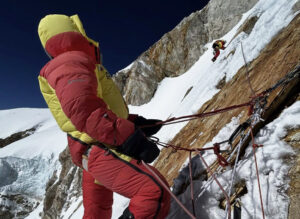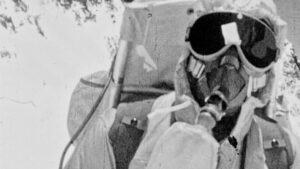When Marco Confortola claimed on July 21 from the summit of Gasherbrum I that he’d climbed all 14 of the 8,000m peaks without oxygen, the reaction was not applause. Instead, the best-known Italian alpinists, starting with Simone Moro and followed by heavyweights like Silvio Mondinelli, Marco Camandona, and even Reinhold Messner — still forceful in his opinions at 80 — accused Confortola of photoshopping summit pictures and making false claims.
This was not the first time doubts have been raised about Confortola’s Himalayan climbs. But only now have so many illustrious mountaineers and fellow Italians spoken on the record. Their skepticism has sparked a new debate about trust and the need for proof in mountaineering.
Kangchenjunga
In 2021, Confortola posted about his summit of Kangchenjunga. To illustrate his success, he included a photo of the summit area. However, he had clearly cropped the image from the photo of a previous summiter — Shehroze Kashif of Pakistan. (Read the entire story here.)
At the time, other climbers on the mountain reported that Confortola showed them some photos taken on the peak’s upper slopes, but not at the summit or anywhere near. Confortola’s outfitter, Seven Summit Treks, refused to comment, but significantly, didn’t include him on their list of summiters.
At the time, we tried to contact Confortola for his side of the story, but he never replied. Nor did we find anyone willing to speak on his behalf. Off the record, we were told he wouldn’t receive a summit certificate. Since then, we have stopped considering Confortola’s achievements a subject of interest.
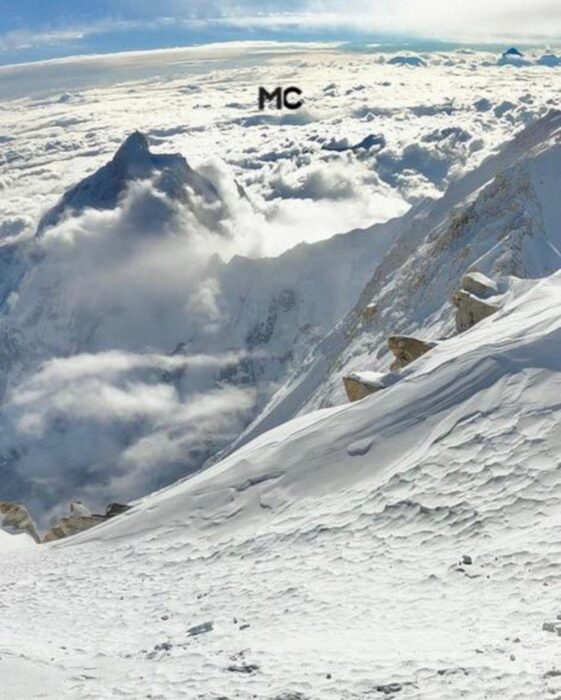
Confortola’s home team published this strange photo of Kangchenjunga’s ‘summit’…
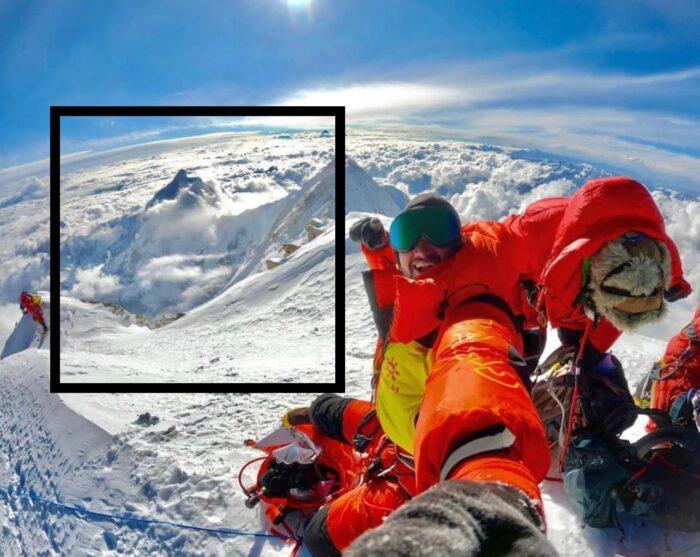
… which happened to be a piece of a larger photo of Shehroze Kashif of Pakistan on the summit of Kangchenjunga. Photo: Shehroze Kashif
Nanga Parbat
Confortola attempted Nanga Parbat in 2023, retreating twice. We covered that season thoroughly, as it was wrapped in drama, with several rescues and one fatality. On July 7, his home team posted a video. They admitted it was not from the summit but claimed that Confortola had reached the top in high winds. Unfortunately, he forgot to connect his InReach, he said.
“Once I reached the summit, I searched for several minutes for the Nepalese flags marking the summit,” Confortola wrote on social media, with no photo to illustrate the feat. “The snowstorm (which arrived shortly after this video) and the cold made me give up, and I began the descent.”
There were no summit pictures or further reports. No one else was there to confirm Confortola’s summit.
Nevertheless, he ticked the peak off his list, leaving only Gasherbrum I to go.
The trigger
On July 21, 2025, we published the following note in a Karakoram update: “Seven Summit Treks reported that Marco Confortola of Italy summited without supplementary oxygen, but was supported by Pasang Ngima Sherpa and Lakpa Tashi.”
The Italian posted a summit video, and his sponsors quickly echoed the triumph.
Confortola posted more details on social media some days later: “I HAVE DONE THE 14,” he wrote in all caps, noting he had climbed the 14×8,000’ers without supplementary 02 between 2004 and 2025, and thus “entered the legend.” He was also happy to join the group of 10 Italians who had climbed the 14×8,000m.
In the following days, the story made a few headlines in Italian media, but when highly influential climbers and fellow Italians Simone Moro and Silvio Mondinelli lent their voices to the controversy, the news became international.
More fake 8,000’ers?
Mondinelli — who is one of those 10 Italians to summit all 14 8,000 peaks — told Lo Scarpone, the news site of the Italian Alpine Club, that Confortola didn’t reach the summit of Annapurna in 2006. Instead, said Mondinelli, he stopped at a ridge 30 minutes away from the highest point, while Mondinelli himself summited.
“At the time, I let it go, but now I’m pissed off that he’s making certain announcements, especially since the list of uncertain climbs has gotten longer,” Mondinelli said.
He also noted a further controversy about Nanga Parbat 2023, to which Confortola responded by sending Lo Scarpone a copy of his summit certificate.
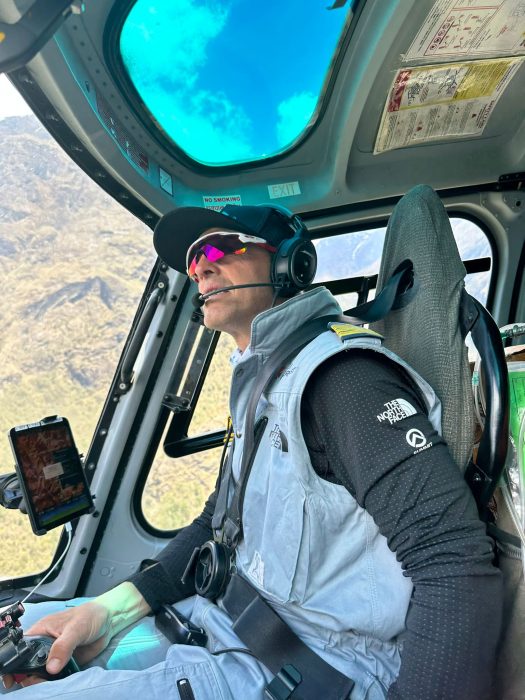
Simone Moro piloting in Nepal. Photo: Simone Moro/Facebook
Simone Moro spoke about the disputed Kangchenjunga summit of 2022. At the time, Moro was a helicopter pilot on the mountain.
“Confortola’s Sherpa [Nuri Sherpa] told me that he had insisted that Marco cover the last stretch to the summit…70 and 100 meters away, even using oxygen. In this way, the Sherpa would also get the summit bonus. And Marco told him: ‘No, for me the summit is here.’ ”
Moro said that other climbers on the mountain also doubted the Italian ever reached the highest point. Moro insists that it’s nothing personal against Confortola. “It’s a question of mountaineering ethics and respect for those who have actually reached the [summit].”
Shortly afterward, Reinhold Messner told La Repubblica: “I am with Moro. The quest for the 8,000’ers, done like that, is stuff for tourists.
“Confortola is not a true alpinist. if you claim a summit, you must provide proof,” Messner added.
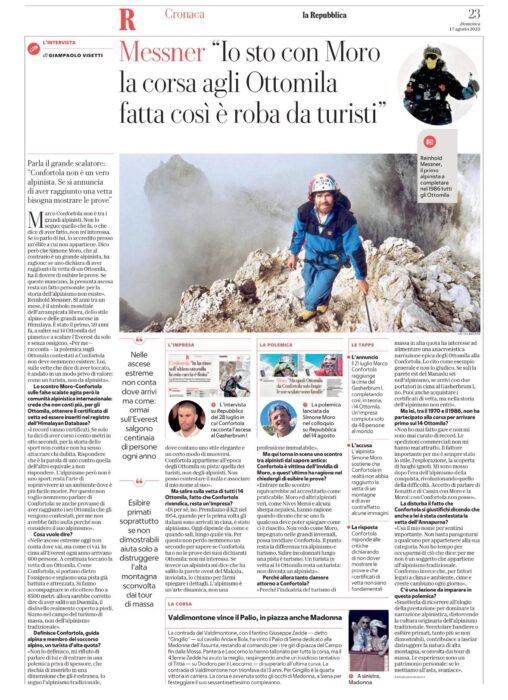
Article in La Repubblica.
Confortola never received a summit certificate for Kangchenjunga, and The Himalayan Database does not list him as a Kangchenjunga summiter.
Scandal grows
Confortola defended himself in an interview with La Stampa by declaring that the criticisms were “all envy…The pros would have been happy if I had died on K2 in 2008,” he said bitterly, referring to the catastrophic season in which several climbers perished when a part of the Great Serac collapsed, burying some climbers and leaving others stranded at 8,500m.
Confortola never offered any proof about Kangchenjunga. Asked about Nuri Sherpa’s testimony, he told Lo Scarpone, “The Sherpa can say whatever he wants.” He then blamed “the agencies” for not granting him a summit certificate.
Despite Confortola’s response, the scandal has continued to grow. Marco Camandona stated that Confortola used his [Camandona’s] Makalu summit picture and photoshopped himself into it.
“I don’t know if Marco Confortola summited Makalu,” he told Montagna.tv. “What I can say with certainty, however, is that he took my Makalu summit photo and manipulated it.”
Here are the two pictures:

Maklau summit pictures of Marco Camandona, left, and Marco Confortola. Photos compiled by Montagna.tv
Dhaulagiri
Camandona also referenced Confortola’s summit photo on Dhaulagiri. He noted that the picture included some geographical features that are clearly not on the summit of Dhaulagiri, but are much lower. Such details can be studied in the research on Dhaulagiri’s summit area that 8000ers.com has done.
As if all this wasn’t enough, Simone Moro then publicly disputed another of Confortola’s summits — Lhotse, in 2013. Moro was not there, but he cited reports from Alex Txikon of Spain, who crossed paths with Confortola as Txikon returned from the summit. Confortola was still well below the top. Txikon says they saw Confortola climb a little further up and then turn around.
Confortola has a Lhotse summit picture, but again, it seems to be someone else’s: Jorge Egocheaga’s, another no-oxygen 14×8,000m summiter, who summited with Txikon. According to Lo Scarpone, Egocheaga told Moro: “As soon as he arrived at base camp, he [Confortola] came to me and asked for the summit photo. I gave it to him and then sadly discovered that he used it for himself. You know, Simone, I don’t like controversy, but it wasn’t nice that he fabricated the summit photo with this lie.’
Here are the two Lhotse pictures, published by Lo Scarpone:

Jorge Egocheaga on the summit of Lhotse. Photo: Lo Scarpone/Italian Alpine Club
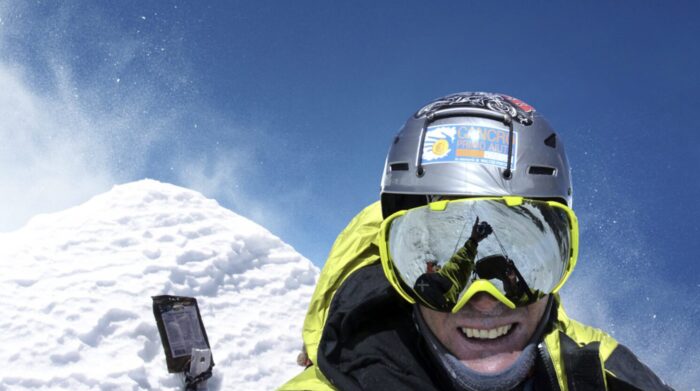
Confortola on the exact same place on Lhotse, with the same light, and the same device on the snow. Photo: Lo Scarpone/Italian Alpine Club
This week, the media all over Europe have picked up on this story. The climbing community has been shocked at the magnitude of the scandal and the number of evidently forged summit pictures.
Revisiting lists
Asked by ExplorersWeb, Billi Bierling of The Himalayan Database made the following statement:
Given the current circumstances, the Himalayan Database team have started their own investigations and have spoken to witnesses and those who have raised their doubts about some of Marco Confortola’s summit claims. Regarding Lhotse, Annapurna 1 and Makalu, the evidence that Marco did not reach the true summit is pretty strong, and we are waiting for responses regarding Dhaulagiri 1. We have also reached out to Marco Confortola to provide some good evidence that he did reach the summit, but have not yet received a response.
We will adjust the Himalayan Database accordingly. The updates will be included in the next update of the HDB, which will be available in November 2025.
The shock has been greater because Confortola is not a beginner trying to impress other non-mountaineers on social media. He is a highly experienced climber, an accredited UIAGM/IFMGA mountain guide, a heavily sponsored athlete, and an active member of the Italian mountain scene.
Credibility issues
The Confortola affair has highlighted some credibility issues in high-altitude climbing:
- A climber’s word is not as trustworthy as it was in the days of the gentlemen amateurs. Sometimes, there are obvious reasons — sponsorship, social media influence, marketing. But it might also be something as intangible as the human ego.
- Making a false claim is easy to get away with, as fellow climbers and expedition companies prefer to stay out of trouble and remain silent, at least on the record. The technology exists to manipulate everything from photos to videos to GPS tracks.
- How many undetected false summits or “no-oxygen ascents” that used bottled oxygen in some way exist in mountaineering? The industry, from agencies to sponsors, focuses almost exclusively on PR-oriented reports — about summits, methods, performance, etc. They prefer to wallpaper over any controversy. But even worse is the silence of other climbers who give the deceivers a pass, even at their own expense.
- There have always been liars among explorers, but their impact is remarkable in mountaineering, which is traditionally imbued with universal values such as respect for the environment, teamwork, humility before nature, endurance, and the willingness to go beyond known limits.



